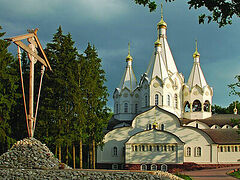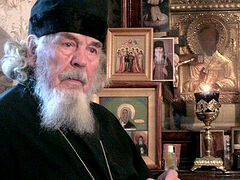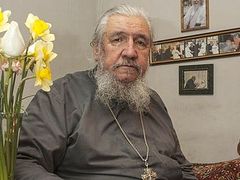The spiritual son of Metropolitan John (Wendland)
December 2 marked the 100th birth anniversary of Archpriest Gleb Alexandrovich Kaleda. A Professor of Geology and Mineralogy, he was secretly ordained a priest in 1972 by Metropolitan John (Wendland; 1909–1989) of Yaroslavl and Rostov. For many years he secretly celebrated the Liturgy at home. In the early 1990s, Fr. Gleb embarked on his ministry openly. He was the first director of the catechetical courses that were later transformed into the Orthodox St. Tikhon’s Theological Institute.1 He became the first priest to engage in prison ministry. Fr. Gleb is the author of wonderful books on Orthodoxy. His children still serve God and the Church.
We offer our readers the reminiscences of journalist Elvira Mezhennaya from Yaroslavl.
 Archpriest Gleb Kaleda My husband and I first met Gleb Alexandrovich Kaleda in 1988 at Metropolitan John (Wendland)’s home in Yaroslavl. We and Vladyka were neighbors—he lived across the road from us. An apartment in a multi-story brick building was given to the retired hierarch by the City Executive Committee, since he did not have his own living space.
Archpriest Gleb Kaleda My husband and I first met Gleb Alexandrovich Kaleda in 1988 at Metropolitan John (Wendland)’s home in Yaroslavl. We and Vladyka were neighbors—he lived across the road from us. An apartment in a multi-story brick building was given to the retired hierarch by the City Executive Committee, since he did not have his own living space.
When we met him by chance, we were struck by the breadth of his personality; and during the year we visited him almost every day on Doronin Street. Vladyka’s personal physician and devoted friend, Elizaveta Alexandrovna Alexandrina (†1999; a secret nun), was always with him.
My husband Anatoly and I were not church-goers back then, and I wasn’t even baptized. But it didn’t matter. We were even given a kind of special love there, as happens with foolish little children in the adult world. This wonderful life lasted just over a year. On February 8, 1989, my husband suddenly died, and on March 25, Vladyka fell asleep in the Lord.
Many people came to visit Metropolitan John in the last year of his life: priests, bishops, former geologist-colleagues, spiritual children, clergy who were ordained by him, and admirers from different cities and countries. Archimandrite Pavel (Gruzdev), a famous spiritual elder, brought pikeperch from the Rybinsk Reservoir, and guests from Uzbekistan sent oriental candies. Remarkably, on a late autumn evening, after the celebrations in honor of St. Sergius of Radonezh, Archbishop Maxim (Krokha; 1928–2002) of Mogilev and Mstislav came from the Holy Trinity-St. Sergius Lavra with a whole bag of gifts. Nuns Eugenia and Eupraxia came with him. Metropolitan John had been friends with the nuns for many years. Vladyka John’s grand-niece Katya (Ekaterina) Fok would travel to him from Moscow. On the major feasts, whole packets of congratulatory letters and telegrams were brought from the neighboring post office.
Elizaveta Alexandrovna went to the post office every day—she recieved letters and parcels with books and magazines from Europe and the USA. Vladyka John was known abroad, where he had served for ten years [in central Europe and North America.—Trans.]. Sometimes an envelope bore his address written in German or English: “City of Yaroslavl, to Metropolitan John Wendland.” Once Elizaveta Alexandrovna with difficulty brought him box weighing eight kilograms, in which the complete multi-volume Philokalia was packaged. This was the first modern edition of this invaluable work, published in Russian after the Revolution.
***
The country was undergoing radical social reform. Such words as “perestroika” (“restructuring”), “democratization”, and “glasnost” appeared in our life. I worked for a newspaper, and my husband was a military judge. Like everyone else, we were seized by those events. Having replaced the old guard in power, the younger leader (Gorbachev) inspired hope for change. The Popular Front was formed in Yaroslavl. In the stadium the crowd booed and hooted at the Communist Party functionaries.
These events were discussed everywhere. Everywhere, but not at Metropolitan John’s—even though Vladyka knew everything and understood what was happening. Even before there were any signs of the the country’s disintegration, he told Elizaveta Alexandrovna to bring her sisters from Latvia to Yaroslavl, saying: “How will they live in a foreign country?” Three nun sisters lived in Jelgava near Riga, where they had moved many years before to help Archimandrite Tavrion (Batozsky), a famous spiritual elder.
The spirit of protest did not penetrate the walls of Vladyka’s small apartment. It was a quiet island in a stormy ocean. Icons hung everywhere, icon lamps burned, and books gleamed with their gilded bindings. During long evenings we listened to recordings of Tchaikovsky’s Divine Liturgy and Rachmaninov’s Vespers. We read together the new spiritual books and publications about the celebration in Moscow of the millennium of the Baptism of Russia. All this was new and extremely interesting. After some time, we were allowed to stay there for prayer.
***
There were two people from Moscow who visited Metropolitan John more often than others: Archpriest Leonid Kuzminov2 and Gleb Alexandrovich Kaleda, a geologist and professor. They had both known Vladyka John from Tashkent. As a boy, Fr. Leonid joined the spiritual family of Bishop Gury (Yegorov; 1891–1965) of Tashkent and Central Asia.
Gleb Alexandrovich first met Archimandrite Gury (Yegorov) after the Great Patriotic War (WWII, 1941–1945), when he returned from the front. Patriarch Alexei I (Simansky) asked Fr. Gury to prepare the Holy Trinity-St. Sergius Lavra for reopening and appointed him its abbot. Then Fr. Gury entrusted Gleb Kaleda to Fr. John (Wendland)’s spiritual guidance. This is how the future metropolitan became the spiritual father of Gleb Kaleda.
 With Metropolitan John (Wendland), January 14, 1989. Gleb Alexandrovich often came to see Vladyka. He was always in a suit and carrying a large briefcase full of papers. It was not surprising for us that one geologist visited another, albeit a former geologist. Naturally, we had no idea that the professor was a secret priest.
With Metropolitan John (Wendland), January 14, 1989. Gleb Alexandrovich often came to see Vladyka. He was always in a suit and carrying a large briefcase full of papers. It was not surprising for us that one geologist visited another, albeit a former geologist. Naturally, we had no idea that the professor was a secret priest.
Tolya [a diminutive form of the name Anatoly.—Trans.], my husband, made small notes about what happened at Vladyka John’s home. And today, after more than thirty years, all the events of those wonderful days can be reconstructed.
When we saw Gleb Alexandrovich for the first time, we had just returned from a trip to the village of Borok on the bank of the Rybinsk Reservoir. The Institute for Biology of Inland Waters of the Academy of Sciences of the USSR was located there. And there was also the museum of the revolutionary Nikolai Morozov. Talking about him, the guide used such descriptions as “the Russian Count of Monte Cristo”, “a prisoner of Shlisselburg Fortress”, and “the last encyclopedist of the twentieth century.” We immediately noticed the book “Christ” written by him (in seven volumes).
In response to our inspired story, Gleb Alexandrovich said one word: “Heresy.” Tolya immediately cooled toward Morozov. We never remembered him again...
The professor spoke with us cheerfully and in his own manner. I remember his stories about the Great Patriotic War—how he miraculously survived in the most incredible circumstances. This happened through his mother’s prayers and thanks to the icon with which she had blessed her son for his military labors.
***
Gleb Alexandrovich went through the whole war. He served as a signaler and took part in the Battle of Stalingrad. He fought at Volkhov, Kursk and East Prussia. I used his memories when I wrote a book about Archbishop Mikhei (Kharkharov; 1921–2005) of Yaroslavl and Rostov. Vladyka was also a signaler at the front. But little is known about this period of his life.
And Fr. Gleb described in detail the work of a front-line signaler in his book, Notes of a Private. Particularly memorable was the episode when, during a battle, he connected the ends of a broken wire. He put an unexploded shell onto one end of the wire and attached a German leaflet to it (it was forbidden to read the leaflets under threat of court martial). In the dark this white speck was easier to see. And he searched the other end with his lips. As Fr. Gleb wrote, they had English wires in the battalion, and the fabric of their shirts was different from the Soviet ones. But one could sense this only with the inside of the lower lip.
When I recently ended up in Volgograd, a local ethnographer kindly showed me the place described by Gleb Kaleda in the aforementioned book without even knowing that I had known the author personally. He was collecting material about the Church clergy who had fought in the war. Archpriest Gleb Kaleda was one of the heroes of his essay.
It was important for my husband and me to learn that bishops and priests of the Russian Orthodox Church are flesh of their people’s flesh. Rudiments of the idea of their imaginary “isolation” are still preserved in people’s heads. And Gleb Alexandrovich Kaleda was one of the first to break these clichés of Soviet propaganda.
***
 Gleb Alexandrovich Kaleda I first saw Fr. Gleb in a priest’s cassock after Metropolitan John’s death—in 1990 in Moscow, when I first came to the Church of St. Elias at Obydensky Lane, and later at his office in Vysokopetrovsky Monastery. Then it was no longer a secret that Metropolitan John had ordained him priest in 1972.
Gleb Alexandrovich Kaleda I first saw Fr. Gleb in a priest’s cassock after Metropolitan John’s death—in 1990 in Moscow, when I first came to the Church of St. Elias at Obydensky Lane, and later at his office in Vysokopetrovsky Monastery. Then it was no longer a secret that Metropolitan John had ordained him priest in 1972.
Gleb Alexandrovich Kaleda thus repeated the special path of service to the Church of Christ, which Metropolitan John himself had trodden. This path, hidden from the persecutors’ eyes, was paved by the fathers of the St. Alexander Nevsky Fraternity, founded in St. Petersburg in 1919.
Throughout the years of his secret service, Fr. Gleb celebrated the Divine Liturgy in his house church, consecrated in honor of all the saints who shone forth in the Russian lands.
We don’t know who gave this name to the house church: whether Fr. Gleb did so on his own initiative or with the blessing of Vladyka John. But the fact that the saints of Russia were especially venerated in the spiritual family of Vladyka Gury (Yegorov) is known for certain. In the 1930s, the then Archimandrite Gury built a secret church of all the Russian saints in the village of Besh-Bala at Fergana in Central Asia. A niche was dug in the earthen floor of an Uzbek hut. The altar of the secret church was placed in it.
During his open ministry in Tashkent, Vladyka Gury also had a church in his house dedicated to the Saints of the Russian lands. Everyone who lived with him—these were the future Metropolitan John (Wendland), the future Archbishop Mikhei (Kharkharov), Elizaveta Nikolaevna Wendland (later Nun Euphrosyne), Abbess Seraphima (Yakovleva) and many others—sang the troparion and kontakion to them every day at the end of both the morning and evening prayers.
Perhaps the young geologist Gleb Kaleda had a chance to pray in that house. The first time he came to Tashkent was in 1951, after his wedding with Lydia Vladimirovna Ambartsumova (1922–2010; ended her days as Nun Georgia). And then every year he took part in expeditions to Central Asia and took every opportunity to meet with his spiritual father.
It is known that Archpriest Gleb Kaleda celebrated the last service in his life to all the saints who shone forth in the Russian lands. His last sermon about the spiritual labors of millions of witnesses, confessors, martyrs and passion-bearers, known and unknown—about his people—was inspired.
 With Metropolitan John (Wendland)
With Metropolitan John (Wendland)
***
After Metropolitan John’s repose I often travelled to Moscow, visiting Fr. Gleb, Fr. Leonid Kuzminov, and the geologist Maria Nikolaevna Solovieva (1924–1994). She was a student of Konstantin Nikolaevich Wendland (the future Vladyka John) in Tashkent. She told me how she broke her leg on an expedition to Central Asia. And Gleb Alexandrovich Kaleda, “Glebushka”, took her down from the mountains on his shoulders: “Gleb was a fearless geologist.”
I carried out their small assignments: bringing or handing something to someone, calling someone... I was a kind of “courier” between Moscow and Yaroslavl. After Metropolitan John’s death, Elizaveta Alexandrovna Alexandrina united everyone. She wrote letters, collected memories of Vladyka, transcribed his sermons, typed texts, and prepared books for publication. She brought materials about Metropolitan John published in newspapers and magazines to Moscow. I visited everyone and brought them her gifts...
The fortieth day after Metropolitan John’s death fell in Bright Week. I celebrated Pascha on April 30 in Moscow, and unexpectedly on my way to Yaroslavl I found myself in the same carriage as Gleb Alexandrovich and Lydia Vladimirovna. They were going to commemorate Vladyka John. It was early May. There was still snow here and there in the forest, but the trees and bushes were already covered with green fluff. Lidia Vladimirovna showed me her Paschal eggs. They had painted them with the whole family as gifts. I got one too.
Not much time had passed since my husband’s death. Gleb Alexandrovich had managed to get to know him, and of course, he understood what I was going through. In addition, he and his wife were travelling to the grave of their spiritual father, who had just passed away as well. But I could see no sorrow, no sadness in them—only Paschal joy. I well remember Lydia Vladimirovna’s kind, sympathetic face. Through the prayers and love of everyone I had met at Metropolitan John’s, I was in that joy too...
And afterwards Fr. Gleb, who had already begun his ministry openly, continued to visit Yaroslavl. He visited Vladyka John’s grave and came to Elizaveta Alexandrovna’s, where we met. Here is an extract from Her diary:
“A few days before Vladyka’s name day, I suddenly saw Father Gleb in the Cathedral of the Feodorovskaya Icon (Metropolitan John is buried next to it). It turned out that he and Lydia Vladimirovna had arrived in Yaroslavl from Moscow on a ship for just a few hours. From the river station we travelled by bus together with the Orthodox priests and laity to the cathedral. We venerated the relics of the wonderworkers of Yaroslavl: holy Right-Believing Princes Theodore and his children David and Constantine. Of course, Father Gleb served a litiya at Vladyka’s grave. He was wearing Metropolitan John’s epitrachelion and cuffs: shiny and pale lilac. I came up and kissed the epitrachelion. Smiling, Father Gleb asked me, ‘You recognize them?’”
To be continued…




